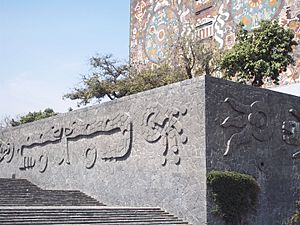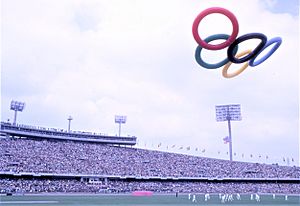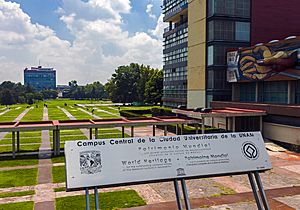Ciudad Universitaria, Mexico City facts for kids

Main Campus of National Autonomous University of Mexico.
|
|
|
Parent institution
|
UNAM |
|---|---|
| Students | 116,506 (2019) |
| Location |
Ciudad Universitaria
,
Mexico
19°19′59″N 99°11′07″W / 19.33309°N 99.18526°W |
| Campus | 1.76 km2 (0.68 sq mi) |
| Official name: Central University City Campus of the Universidad Nacional Autónoma de México (UNAM) | |
| Type: | Cultural |
| Criteria: | i, ii, iv |
| Designated: | 2007 (31st session) |
| Reference #: | 1250 |
| Region: | Latin America and the Caribbean |
Ciudad Universitaria (which means University City) is the main campus of the National Autonomous University of Mexico (UNAM). It is located in the southern part of Mexico City. This huge campus was designed by famous architects Mario Pani and Enrique del Moral.
The campus includes the Olympic Stadium, about 40 different schools and research centers, a Cultural Center, and a special nature area. It also has the Central Library, the National Library of Mexico, and several museums. Ciudad Universitaria was built in the 1950s on an old, hardened lava field. It was finished in 1954 and cost about $25 million. In 2007, UNESCO named it a World Heritage Site. People often call it "C.U." for short, and it is a very important symbol of the university.
Contents
Exploring the Campus Atmosphere
Ciudad Universitaria is a large, open space that many families enjoy visiting on Sundays. They like to explore its patios, gardens, and walking paths. The campus was built on a thick layer of lava. This lava was left behind by the Xitle volcano around 100 AD.
Because of the natural landscape, there are not many straight roads here. The roads usually curve in circles, with buildings located inside these loops. Some buildings require a short walk to reach them. Volcanic rock was removed to make space for buildings. This same rock was then used to create pathways and outer walls. Most buildings are made from common materials like concrete and brick. They often have large windows and gardens, both inside and outside. Most buildings are only two or three floors tall.
Two buildings stand out: the Rectorate Tower and the Central Library. These tall, square buildings are decorated with amazing murals. Famous Mexican artists created these murals. David Alfaro Siqueiros painted the Rectorate Tower. Juan O'Gorman created the murals on the Central Library.
The Central Library's mural is known as the largest mural in the world. It covers all sides of the building. The artwork shows Aztec and Spanish designs, along with UNAM's coat of arms. This makes the Central Library the most famous building on campus. The original campus, called Campus Central, was built in 1943. It covers a large area, and Insurgentes Avenue runs through it.
Sculptural Space
Inside the campus's nature reserve, you can find the Sculptural Space. This area features a large, round, hardened lava bed. It is surrounded by many white triangular shapes that look like rays from the center, similar to a sunflower. Many large, colorful metal sculptures by modern artists are placed around this area. This is how the space got its name.
University Buildings
The economics building was designed by Vladimir Kaspé and J. Hanhausen. It first opened in 1953.
Eugenio Peschard designed the science building. It features a mural called The Conquest of Energy. This artwork was created by José Chávez Morado.
Campus Museums
Ciudad Universitaria has several interesting museums:
- UNIVERSUM, the Science Museum. This museum has hands-on exhibits about science for everyone.
- University Museum for the Sciences and Arts (MUCA). It shows modern art from Mexican artists. It also displays art owned by the university.
- University Museum of Contemporary Art (MUAC). This museum focuses on modern art.
- National Biodiversity Pavilion. This pavilion explores the diversity of life.
Sports Facilities
The Mexico '68 Olympic Stadium was built in 1952. It hosted the 1955 Pan-American Games and the 1968 Summer Olympic Games. The stadium is on the Campus Central part of the university. Its stands were built using lava rock dug from the site. These stands also feature designs by Diego Rivera. The stadium was also used for the 1986 FIFA World Cup. Today, it hosts football matches for the university league. It is also the home stadium for the university's professional football team, the "Pumas". The stadium has a race track too. This track has been used for international athletic events.
Another famous part of Ciudad Universitaria is the "Frontones" area. This area includes a multi-purpose building and ten courts for racquetball and handball.
There are also football fields for student and children's teams to practice. Gyms for martial arts, boxing, and other sports are located near the stadium. These are mainly for students.
Cultural Life on Campus
Ciudad Universitaria is a very important part of Mexico City's cultural scene. The campus has many places for cultural activities. These include music, theater, cinema, and visual arts. Most of the university's schools have exhibition spaces and auditoriums for these events.
The University Cultural Centre (Centro Cultural Universitario) is a special part of the campus. It contains the main auditoriums, theaters, and cinemas. It also has one of Mexico's newest modern art museums, the Museo Universitario de Arte Contemporáneo.
The Centre also has facilities named after important figures in Mexican history:
- Sala Nezahualcoyotl. This hall is used for orchestra and dance performances.
- Teatro Juan Ruiz de Alarcón. This is a major theater for both classic and modern plays.
- Foro Sor Juana Inés de la Cruz. This is a smaller theater, mainly for modern plays.
- Centro Universitario de Teatro (CUT). This is a small theater with about 100 seats. It is connected to the theater school.
- Sala José Revueltas and Sala Julio Bracho. These are cinema theaters. They show a wide variety of Mexican and international films.
- Sala Miguel Covarrubias. This is a small theater used for dancing.
- Radio UNAM. This is the university's radio station. It broadcasts music, cultural programs, news, and entertainment.
World Heritage Site Status
Ciudad Universitaria became a World Heritage Site after a visit in 2005. Francesco Bandarin, who was the Director of the World Heritage Center, recommended it. The campus was recognized as a brilliant example of urban design and architecture. It is also known for combining modern architecture with Mexican traditions and art. This includes works by David Alfaro Siqueiros, José Chávez Morado, and Francisco Eppens.
Getting Around Campus
The university provides a free bus system called Pumabús. There are eleven main bus routes within Ciudad Universitaria. Routes 1 to 5 start near the metro exit for Metro Universidad station. Three other routes (6, 7, 8) start at parking lot number 1 of the Olympic stadium. These buses run from Monday to Friday, from 6:20 AM until 10:30 PM. Cars are allowed on campus, and taxis also take groups of passengers along the bus routes. Some routes have longer and shorter versions. There is also a temporary route for new students going to the registration center.
There are three main ways to enter Ciudad Universitaria. Two entrances are from the metro stations: Metro Universidad and Metro Copilco. The third is from Avenida Insurgentes. This important avenue runs north to south, dividing Ciudad Universitaria in half. Two Metrobús stations, Ciudad Universitaria and Centro Cultural Universitario, also provide access to the campus. This avenue helps people reach other parts of the city. It is also near the Olympic Stadium and the Cultural Zone.
Recently, a program called "C.U. Limpia" (Clean C.U.) started. It offers 58 bicycle stations around Ciudad Universitaria. Each station has 200 new bicycles. Students can rent these bikes and return them to any other station. This program has become very popular with students and teachers. It helps promote a cleaner way to travel.
Campus Safety
Even though Ciudad Universitaria is very large and does not have entry controls, it is a safe place for students and visitors. There is a special security group called "Auxilio UNAM" (UNAM Help). They patrol the campus all day, especially on holidays and weekends. They do not carry firearms. They use hummers, motorcycles, and golf carts to get around. For historical and legal reasons, regular police officers do not enter Ciudad Universitaria. They only come if the university authorities specifically ask them to. Crimes do happen, but they are rare. They usually occur late at night when most people have left. The campus also has an emergency medical station and a fire station.
Shops and Food on Campus
There are cafeterias owned by the university all around the campus. These are run by cooperatives, except for the cafeteria at the Faculty of Sciences (called Café Ciencias), which is run by students. These cafeterias are permanent, one-story buildings that look very similar. There are also small, permanent shops next to some buildings where a full cafeteria would not fit. Some of these shops offer photocopies and office supplies instead of food.
Some semi-permanent shops are also found around the campus. They mostly sell candies and packaged food. These shops are set up and taken down every day, but they stay in the same spot for years. A few shops sell university souvenirs, especially items related to the soccer team. Around the campus, especially between the Central Library and the Faculty of Philosophy and Literature, you can find people selling crafts. They also sell music, films, and books, some used and some new.
Near the metro stations close to the university, there are many food shops. You can also find bookstores, photocopy shops, and photo studios. Near the northern station, Copilco, just outside Ciudad Universitaria, there are many printing shops. Students go there to get their theses bound.
Near Metro Universidad station, at the edge of Ciudad Universitaria, is the "Tienda UNAM" or UNAM Store. This is a large supermarket run by the university. It sells furniture, clothing, food, drinks, vegetables, electronics, computers, toys, and many other items. It is meant for university employees and their families, but it is open to everyone.
Images for kids
See also
 In Spanish: Ciudad Universitaria (Universidad Nacional Autónoma de México) para niños
In Spanish: Ciudad Universitaria (Universidad Nacional Autónoma de México) para niños













